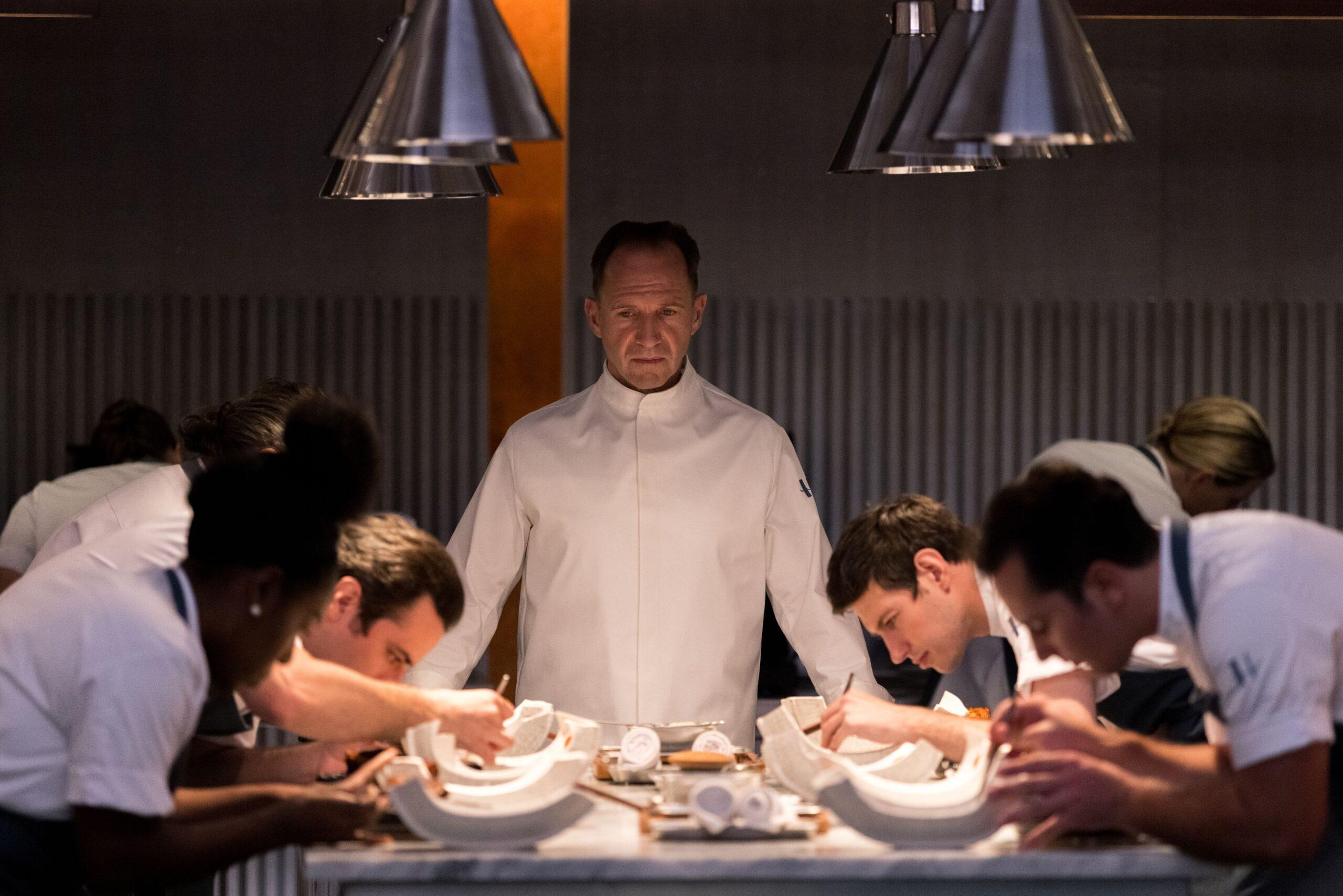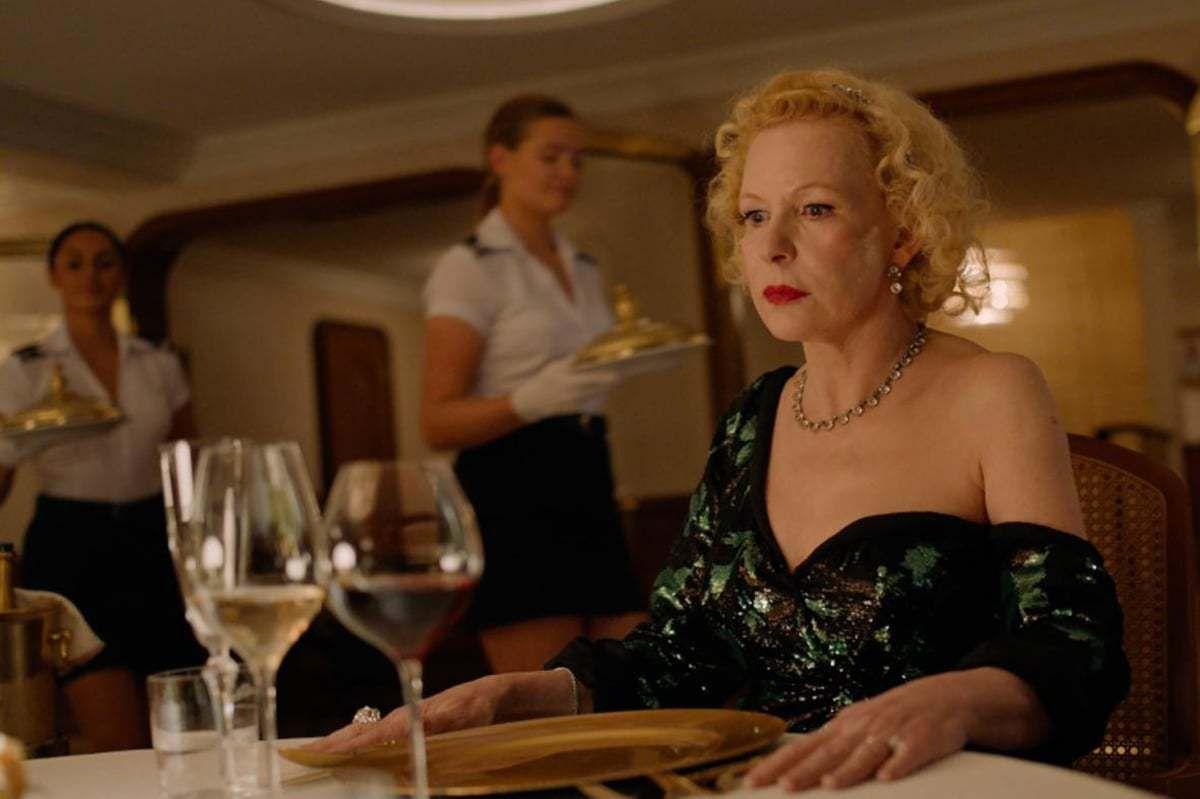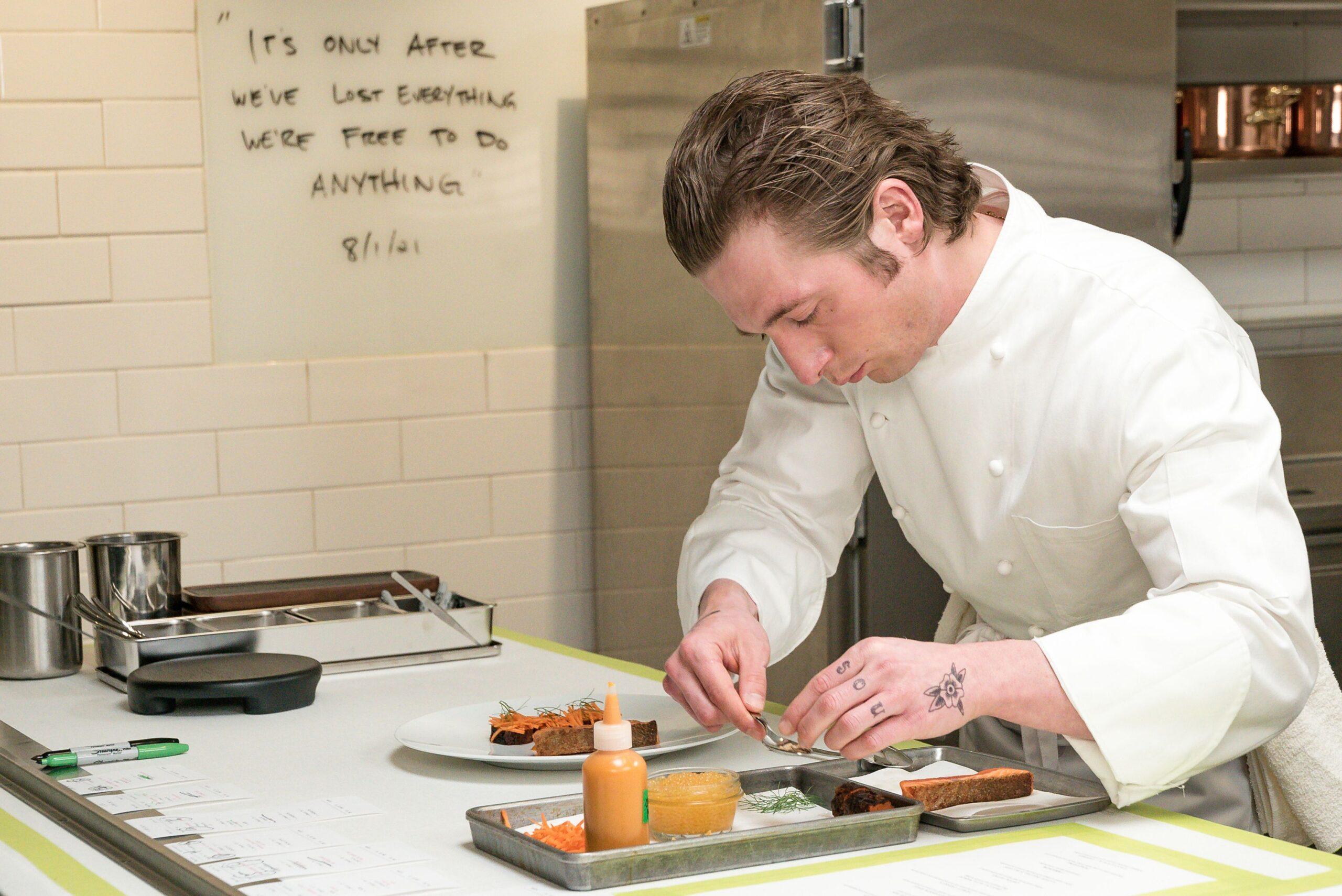In The Menu, the movie that skewers fine dining and hits theaters this week, an unlucky dozen restaurant patrons are repeatedly and coolly informed that they will not live to see the morning. They stare down the barrels of bones filled with marrow; they struggle over knives and are chased—hunted, really—through gnarled maritime island woods. They witness death and dismemberment before them, spectacles that incorporate protective plastic wrap and smeared blood. They are cursed with whispered dicta such as: You will get less than you desire and more than you deserve. They are, it may seem, living in a sort of salt-fat-acid-heat version of Saw.
And yet to hear the creative team behind The Menu tell it, they didn’t set out with the goal of creating some sort of chef-forward entry into slasher flick canon. “I never really saw it as a horror movie,” says The Menu director Mark Mylod in a Zoom conversation. “That wasn’t my approach.” Nor was it the stated goal of Will Tracy and Seth Reiss, the pair of former Onion colleagues who wrote The Menu’s screenplay about an exclusive umpteen-course private-island celebrity-chef dinner that unravels, amusingly and alarmingly, over the course of one crazy night. “We never even used the word horror,” Tracy tells The Ringer. “I think we knew that the darker and tenser it gets in that room, the funnier it gets. So we probably were still thinking comedy first.”
Good cooking is all about layering flavors and textures, however, and in this case the resulting concoction is what you might call haute horror: a cinematic omakase of chilling politesse, charming palate cleansers, and chunks of viscera served over and over, whether you’re still hungry or not.
It’s a flavor profile that isn’t limited to The Menu; a number of other recent works have served up a similar mouthfeel as well. In Triangle of Sadness, Ruben Östlund’s Palme d’Or–winning entry at the Cannes Film Festival earlier this year, vomit spatters across a cruise ship window like blood while gelatinous, gastronomic blobs quiver untouched on fancy dining room plates, looking like rogue eyeballs. (“Better to eat something,” the staff tells one lady who is about to spew, sounding like the witch in Hansel and Gretel: “Seasickness is worse on an empty stomach.”) The Bear, the TV series that follows a striving, hardscrabble chef from a Michelin-starred, bleach-perfect evil laboratory of a kitchen to the more chaotic realm of a Chicago hot-beef-slangin’ joint, doesn’t feature quite so many bodily fluids. But it is nevertheless so precise in its depiction of a world-renowned-yet-mentally-abusive kitchen that it was hard for many restaurant industry workers to watch. In Season 2 of The White Lotus, every stilted brunch feels like the shower scene from Psycho, while an ongoing series of unintentional cat-and-mouse restaurant encounters between a lowly, beleaguered assistant and her capricious, floundering half-billionaire boss begin to feel like the dining equivalent of It Follows.
On screen as in life, dinner tables have always been hubs of gossip and insecurities and revelations and outbursts, of envelopes being slid across tabletops and hands being held underneath. But lately, on television and in theaters, they’ve also become wheels of torture, and chopping blocks, and the new hottest spots where best-laid plans and insufferable-but-trying characters go to, well, die.

Tracy was on his honeymoon in Norway years ago when he and his wife went to a restaurant accessible only by a small boat. As he watched the boat pull away from the dock upon disembarking, he nervously remarked that they’d be in big trouble if something went awry and they needed to escape. Hey, that could be a story, he thought. He and Reiss, who first started working together at The Onion in the late aughts, had tried to write a film before; it was “more purely Onion-y comedic,” Tracy says. “Didn’t find there was much of a market for it.” Brainstorming their next move at dinner one night, he mentioned to Reiss that he did have this one idea bouncing around …
“As soon as Will pitched that, it was almost like an Onion headline,” says Reiss. “You’re like, ‘Oh, that’s good.’” (If there’s an actual Onion headline that best describes the vibe of The Menu, it’s probably this one: “‘Keep Going,’ Says Restaurant Patron Watching Server Out Of Cheese Start To Grate Hand.”) They particularly liked the concept of arranging the movie like a hoity-toity tasting menu. “So if you’re ever feeling like, fuck, what do we do next?” says Tracy, “well, you just move on to the next course, and the next course would be somehow escalating what we saw.”
And escalate it does. The Menu begins with a dozen finicky diners—among them a trio of private equity bros; a miserable old bored rich couple; a washed-up movie star and his over-it assistant; a narcissistic restaurant critic and her toady editor; and a jilted food nerd and his newest date—waiting for their ferry to Hawthorne, a farm-fresh restaurant named after a stinking flower and inspired by real-life elite global dining destinations like El Bulli, Noma, and Fäviken. Once they arrive, they meet both the severe, abrupt hostess Elsa and the inscrutable chef Julian Slowik, played by Ralph Fiennes.
“We harvest,” says Elsa, showing everyone around the beaches and gardens of the island, explaining Hawthorne’s circle of life. “We ferment. We slaughter. We marinate. We liquify. We spherify. We gel.” Slowik is a culinary genius and the commander of a kitchen militia that lives in a barrack and comes armed with lofty foams and snows and essences and control of “entire ecosystems.” Slowik’s celebrated, complicated menus tend to have a theme. And as the sun goes down and the light shifts from the ocean horizon to the harsh kitchen, and the getaway boat remains miles and miles away from the shore, the theme of the evening turns out to be, pretty much: Why haven’t you really tried to escape?
“I think the horror genre element is really inherent to the structure of the story,” says Mylod, “in that there are a lot of people trying to survive within an enclosed space.” In the midst of working on The Menu, Mylod and Tracy also collaborated on the Succession episode “Tern Haven,” which revolves around a disastrous dinner between two warring yet cordial families. For that project, Mylod found lots of inspiration in Robert Altman and Gosford Park. For The Menu, he was influenced by (and assigned to his actors as homework) a different film, the surrealist Mexican satire The Exterminating Angel, which tells the story of a fancy dinner party that no one can bring themselves to leave.
Being stuck in the restaurant serves to ratchet up a strain that already existed. “I find a tension in all fancy food,” says Mylod. “I feel a pressure to appreciate it in a way that I probably do not and never have.” It feels, he says, like attending the ballet: being performative about someone’s performance. Reiss and Tracy compare it to another art form, a museum. “Part of the tension is you’re sitting there patiently, waiting for the artist to present the thing,” Tracy says. “But there’s also some animal child inside that says, I want my meat and I want to put it in my mouth and I want to digest it now. I want the nutrients. I need them. But you have to be very civil and you have to be patient.”
“Yeah, if you’re looking at paintings,” adds Reiss, “you can look and appreciate and then move on. But with food, it’s like you love and appreciate it, but then you want to fuckin’ eat it.”
“But still, you have to sort of act like a museum patron,” says Tracy, “while at the same time knowing that, unlike the art museum, this art is literally going to turn to shit.”

Shit is what truly elevates Triangle of Sadness, transforming it from a social satire about fashion, influence, and beauty-as-currency into a ride that is as rollicking and nauseating as a cruise ship listing about in a storm. While he was researching the film, Swedish writer and director Östlund hopped on a vessel called the Sea Cloud and saw for himself how quickly an evening in the dining room could devolve. One night, inclement weather tossed the boat to and fro as guests tried in vain to enjoy a buffet.
“I was brought up on an island,” says Östlund, “so I’m quite used to the ocean, and so on. I don’t get seasick, really. So I could sit in that room and really study how people were behaving.” Slowly, he said, everything got eerily quiet: The chatter in the room dissipated as queasy patrons began focusing inward, silently pleading with their bodies. “People are starting to concentrate,” he says. “And you can see that they are scared.” Then the upchucking began. “I thought it was much more interesting to look at the people who were not vomiting,” he says. “How should they behave?”
In the movie, as in life, everyone tries to cling to the social contract even as high-society stomachs roil around them. The patrons keep eating, each morsel a mountain. The waitstaff keeps reappearing from the kitchen, one hand tucked crisply behind each back, the other hand bearing shiny crown jewels of the sea—oysters; sea urchins; octopi—that are flayed out on fine china. (A Swedish chef named Gustav Tragardh helped pick out a menu that was as pungent as possible.) It doesn’t take long before the distress really sets in.
As a filmmaker, Östlund has shot many a scene that revolve around an uncomfortable dinner. In the après-avalanche Force Majeure, couples fight and squirm and sip water and everyone smiles so tightly you expect their faces to implode. In The Square, a fancy gala turns hectic when a performance artist posing as a primate begins wreaking havoc. (According to the L.A. Times, Östlund filled the tables in that scene with actual art-world movers and shakers to make their intrigued-yet-uneasy reactions feel more authentic.) Triangle of Sadness features some of this psychological thriller energy too; in particular, an early, painfully protracted scene in which a couple argues over who’s got the check.
But Triangle of Sadness doesn’t just plumb the emotionally unavailable depths of polite society. It goes ahead and overwhelms the plumbing altogether, sending a literal shitstorm down the cruise ship corridors like the Targaryen blood in the opening credits of House of the Dragon. This may not be traditional gorecore, but it’s just as likely to leave a viewer in the fetal position, peeking out between fingers, toes curling in primal response as some poor body’s insides force their way out into the world. The social contract doesn’t have much to say about the appropriate response to such horror—such intestinal collapse—and at a certain point the only choice left is delirious laughter.
Some of Östlund’s earliest work prepared him to truly send it, so to speak, when it came to serving up this degree of body horror on film. For years he shot ski movies, capturing acts of physical progression: the skiers who could spin 180 degrees more than anyone else ever had, or who could jump 1 meter higher, or who could access a location that had previously sat unpoached. In Triangle of Sadness, he had the same ambition: to showcase feats of faster-higher-stronger-more; to show audiences something they’d never quite seen.
He remembered the buffet on the Sea Cloud. He envisioned a set that physically swayed from side to side during filming. His sous-crew made it happen, even though they had to nibble on ginger candies throughout that part of production to ward off motion sickness. The result was a glut of footage of people sliding around in pools of their own selves, as gruesome as any murderous chainsaw rampage.
“With the vomiting incidents,” Östlund explains, “since that’s basically a little cheesy, I felt I had to push [the scenes] quite much further than the audience expects. Otherwise, they will not become anything. Then they will only be cheesy. But if you push it 10 steps further than the audience expects, then they will probably become something else.” Sometimes, you just gotta let things cook a little bit longer to get that vital sizzle. Sometimes, there’s nothing tastier than a good old cheeseburger, forged in onions and blood.

Food is life, which is why it’s such an effective motivator, both on an individual and a societal level. Near the beginning of Triangle of Sadness, three jars of Nutella are delivered by helicopter to the cruise ship at the whim of a (Russian fertilizer billionaire) guest; by the end, characters are whacking donkeys for sustenance, spraying Evian facial mist aerosols directly into their mouths for hydration, and sneaking pilfered pretzel sticks behind rocks as if they’re soldiers savoring cigarettes in the trenches. One particularly attractive dude, facing a prolonged survival scenario, learns he can barter his looks (and, ah, a little bit of effort) for fresh fish and more pretzels—a scenario that is simultaneously harrowing and as good as it gets. Östlund loves to use random YouTube videos as inspiration, and two of the ones he thought about while filming Triangle of Sadness involved the way monkeys and dogs reacted to hunger and food with jealousy and shame.
In The Bear and in The Menu, the food is both the tension and the release, the carrot and the stick. (In The White Lotus, it’s something that characters can push around their plates while life collapses around them.) When The Bear, a savage slice-of-life glimpse into the world of Chicago cuisine, first aired, the phrase “Yes, Chef!” became part of viewers’ daily lexicon, reaching beyond restaurant walls and into normies’ homes. But “Yes, Chef!” isn’t always an affirmative. The fine dining grindset can be well-oiled or totally slimy, and in The Bear the salute is used both to empower and to belittle, to build people up and to break them down. It is a whole anxiety dream of a phrase, a staccato reminder of the psychological competition that takes place in professional kitchens—particularly, in the case of The Bear, at highfalutin restaurants like the one where the protagonist Carmy previously, and miserably, worked. (Carmy is played by Jeremy Allen White, whom Mylod once upon a time cast as Lip in the series Shameless. “I feel a kind of strange paternal pride,” Mylod says of White’s “brilliant” work in The Bear.)
“I was throwing up every day before work,” Carmy admits to his sister about his haute cuisine days in The Bear, both of them in the weeds of familial grief and open tickets. “Then why’d you stay there?” she says. “I don’t know,” he says, sounding a lot like the characters in The Menu as they huddle in fear. “Um, people loved the food. It felt good. Chef always says a big part of the job is taking care of people, right?”
Well, maybe. In thinking about his character in The Menu, Fiennes said he envisioned a person with no fancy logo or flair on his costume; that he was akin to a professional caretaker just wearing an anonymous uniform, like a surgeon or a priest. (A surgeon, a priest, and a chef walk into a bar—now there’s a terrifying premise, though also a regular occurance in the North End of Boston.) Of course, in the world of horror, it’s the people who are meant to be tending to your body or spirit who need to be watched most of all.
Back when they lived in Chicago, Tracy sometimes used to take Reiss to EL Ideas, an inventive Michelin-starred prix fixe restaurant, helmed by the unpredictable chef Phillip Foss, that involved rather vibrant gimmicks (a mirror, a razor, and powder!) as well as some storytelling before every course. Foss—who once quit another job at a fine restaurant to start a food truck called Meatyballs—asked them if he could attend an Onion pitch meeting sometime for creative inspiration. That’s when it clicked for Reiss: “Oh, yes, chef as artist, chef as creator, chef as someone who’s working with all these people and getting pitches,” he says. “You can map it onto a lot of creative endeavors.” While The Menu wasn’t created to be a horror film, it was an attempt to delve into how the artistic mind risks getting pickled if it marinates too long in all of its own impulses—an unsettling thought, and a constant one for Tracy and Reiss. “Some of the best comedies are horrific and some of the best horror movies I see as comedies,” says Tracy. “You’re kind of trying to manage tension in a similar way.” So much nervous laughter, so many misunderstandings.
At a panel following a screening of The Menu at the Toronto Film Festival, Fiennes was asked about playing the movie’s villain, a line of inquiry he rejected. “I think he’s a good guy,” he said. “We didn’t want to be anywhere near the idea of a movie baddie,” Mylod explains to The Ringer. “Instead, we both saw him as an artist in pain, consumed with self-loathing for the choices he’s made that led him to this place.” Fiennes originally envisioned a lot more screaming and yelling, but in consultation with chef Dominique Crenn—who is at the helm of two different restaurants with four Michelin stars between them—he learned the value, and the power, of keeping things a bit more orderly and quiet, though no less deadly.
“There is beauty in this character,” insists Crenn, who tells The Ringer that the scariest food she could contemplate would be anything that comes from a can and thus “doesn’t have any story” behind it. (Crenn is always on the lookout for someone else’s cooking: “I want to eat their story!” she exclaims.) For The Menu, Crenn helped conceive of a course that is titled “Man’s Folly” and involves some light stabbing. “He is so sensitive,” she adds about Chef Slowik, in much the same way one might say that Jason Voorhees is just a lost soul. Still, she makes an interesting point: In films that dish up haunted cuisine and haute horror, maybe the all-powerful big bad final boss isn’t the chef so much as the table.
Once sat, after all, it’s so hard to get up and walk out. Once the food is set down, it’s so hard to resist! Östlund has a friend in Sweden with a restaurant that serves course after decadent course, and “they have to actually clean up from people vomiting in the toilet every night because people can’t handle that much food,” he says, chuckling and relishing the inconvenient, messy way that bodies have minds of their own. “I like social horror,” he says. “I don’t like violence so much.” He’s currently working on his next film, The Entertainment System Is Down, which takes place on a plane and involves cheese sandwiches and mineral water in the role of pretzel sticks and Evian face mist.
Sometimes, when he discusses his Triangle of Sadness process, Östlund sounds downright cheflike. He likes to compile shots, he says, and somewhere around take 20, he gives everyone a half-hour break. When they return, there are five takes left, and he tries to imbue them with a sense of in-the-moment urgency by counting down. He gathers the whole crew to stand behind the camera. “Everybody is there now,” he says, “and we are playing an important, important football game together, and we are going to win it together.” On the final take, in lieu of saying action, he bangs a gong. Everyone hangs on to the vibrations until they die out. Only then are the actors free to begin, present and ready—yes, chef!—to serve.
